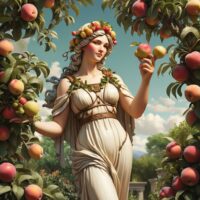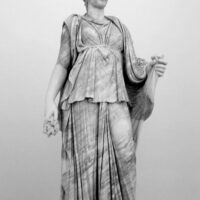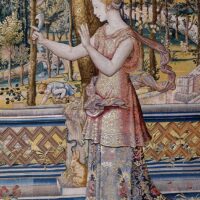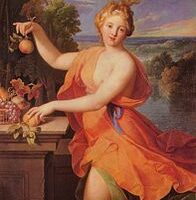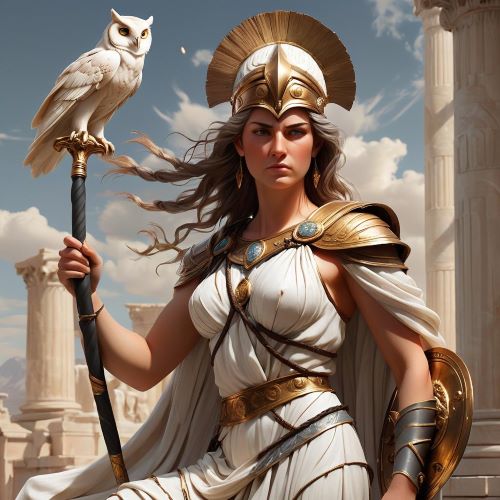Pomona : Goddess of Fruit Trees
Listen
At a glance
| Description | |
|---|---|
| Origin | Roman Mythology |
| Classification | Gods |
| Family Members | N/A |
| Region | Italy |
| Associated With | Fruit Trees, Gardens, Orchards |
Pomona
Introduction
Pomona, a prominent figure in Roman mythology, is revered as the goddess of fruit trees, gardens, and orchards. Unlike many Roman deities, she has no direct counterpart in Greek mythology, making her a uniquely Roman figure. Her name, derived from the Latin word “pomum,” meaning fruit, reflects her close ties to fruit-bearing trees. Pomona’s primary role was to oversee the cultivation and growth of fruit trees, symbolizing abundance and prosperity in ancient Rome. As a deity central to an agricultural society, she ensured the bountiful harvests that sustained the people. Celebrated during festivals marking seasonal changes, Pomona embodies fertility and the nurturing of nature, particularly fruit trees and gardens. Her exclusive focus on the flourishing of plants distinguishes her from other harvest-related deities, further emphasizing her significance in Roman culture.
Physical Traits
Pomona is typically depicted as a youthful and radiant figure, embodying the vitality and fertility of nature. She is often shown adorned with garlands of flowers and fruits, symbolizing abundance. Her attire, simple and earthy, reflects her deep connection to the natural world. In artistic representations, Pomona is frequently seen holding a platter of fruit or a cornucopia, emblematic of the harvest’s bounty. A pruning knife is often included in her imagery, emphasizing her role in the careful cultivation of fruit trees. Surrounded by blooming orchards and lush landscapes, she personifies the nurturing spirit of nature, enhancing the earth’s life and abundance.
Family
Pomona’s connections within Roman mythology are less detailed compared to other deities, but she is intimately linked with Vertumnus, the god of seasons and plant growth. Vertumnus, deeply in love with Pomona, used various disguises to win her heart, eventually succeeding by transforming into an old woman who persuaded Pomona of his genuine affection. Their union represents the harmony between nature’s nurturing forces and the cyclical changes of the seasons. Pomona is sometimes associated with Ceres, the goddess of agriculture, and Flora, the goddess of spring, reflecting her ties to fertility and the natural world. Though not extensively documented, these connections highlight Pomona’s role in the broader agricultural pantheon. Celebrations for both Pomona and Vertumnus occur on August 13, marking the early harvest and underscoring their shared significance in ensuring the earth’s bounty.
Other names
Pomona, the Roman goddess of fruit trees, was also known by various names and epithets that emphasized her role in agriculture. Titles like “Pomona Malifera” (apple-bearing Pomona) and “Pomona Sativa” (cultivated Pomona) highlight her connection to fruit-bearing trees and the cultivation of orchards. While she does not have a direct Greek counterpart, Pomona’s name, derived from the Latin word “pomum” (meaning fruit), reflects her deep association with fertility and the natural world. Occasionally, she is loosely compared to Greek goddesses like Demeter or Opora, who oversee harvests, but Pomona’s focus on fruit trees makes her uniquely Roman. Despite her relatively few alternative names, she is sometimes referred to as the “Goddess of Fruit” or the “Fruitful One,” underscoring her central role in the prosperity of orchards and gardens.
Powers and Abilities
Pomona’s divine powers are integral to her role as the goddess of fruit trees and gardens. She oversees the growth and protection of orchards, ensuring their prosperity and productivity. With the ability to influence plant health, Pomona is a key figure for farmers and gardeners seeking fruitful harvests. Her powers extend to safeguarding crops from pests and diseases, and she is also revered for her association with fertility, often invoked by couples wishing for children.
Among her notable abilities, Pomona wields chlorokinesis, allowing her to control and enhance plant growth, leading to abundant greenery and harvests. She also has karpokinesis, which affects the growth and yield of fruits. Pomona’s powers symbolize her role as both a protector and enhancer of agricultural life.
Additionally, Pomona can create impenetrable barriers to protect her sacred gardens from intruders. This aspect of her powers, described in Ovid’s writings, underscores her desire for solitude and the careful nurturing of her plants. These qualities reflect her dual nature as both a guardian and a nurturer within the natural world.
Modern Day Influence
Despite being a lesser-known figure in Roman mythology, Pomona’s legacy is evident in modern culture. Her name is linked to Pomona, California, a vibrant community celebrated for its cultural richness, including the Pomona Arts Colony, which features murals, galleries, and performances that highlight local creativity. This connection underscores Pomona’s continuing relevance, reflecting themes of abundance and artistic expression.
Pomona’s association with fruit also persists in contemporary celebrations. Traditions during autumn harvests, including modern activities like bobbing for apples, echo the ancient Roman festival held on August 13. These practices emphasize gratitude for nature’s bounty, particularly apples, which are symbolically tied to Pomona.
Her influence extends into literature and popular culture as well. For instance, Professor Pomona Sprout in the Harry Potter series embodies values of growth and nurturing, linking her to modern narratives about nature and education. Pomona’s presence is also notable in Pomona College in California and the city of Pomona, reflecting her enduring connection to growth and agriculture.
Additionally, the asteroid 32 Pomona, discovered in 1854, is named in her honor, further highlighting her lasting impact. Her symbolism of fertility, abundance, and natural beauty continues to inspire and resonate with people today, both in educational institutions and popular culture.
Related Images
Frequently Asked Questions
What is lorem Ipsum?
I am text block. Click edit button to change this text. Lorem ipsum dolor sit amet, consectetur adipiscing elit. Ut elit tellus, luctus nec ullamcorper mattis, pulvinar dapibus leo.
What is lorem Ipsum?
I am text block. Click edit button to change this text. Lorem ipsum dolor sit amet, consectetur adipiscing elit. Ut elit tellus, luctus nec ullamcorper mattis, pulvinar dapibus leo.
What is lorem Ipsum?
I am text block. Click edit button to change this text. Lorem ipsum dolor sit amet, consectetur adipiscing elit. Ut elit tellus, luctus nec ullamcorper mattis, pulvinar dapibus leo.
What is lorem Ipsum?
I am text block. Click edit button to change this text. Lorem ipsum dolor sit amet, consectetur adipiscing elit. Ut elit tellus, luctus nec ullamcorper mattis, pulvinar dapibus leo.
What is lorem Ipsum?
I am text block. Click edit button to change this text. Lorem ipsum dolor sit amet, consectetur adipiscing elit. Ut elit tellus, luctus nec ullamcorper mattis, pulvinar dapibus leo.

